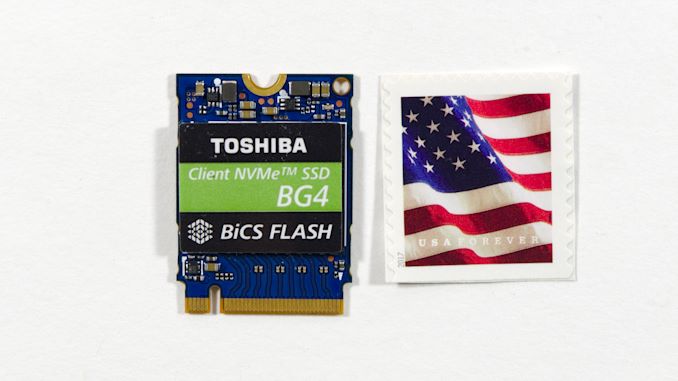The Toshiba/Kioxia BG4 1TB SSD Review: A Look At Your Next Laptop's SSD
by Billy Tallis on October 18, 2019 11:30 AM ESTConclusion
The Toshiba/Kioxia BG4 is a rather specialized SSD, intended for thin and light systems that need to maximize battery life and conserve internal volume. It's an OEM-only product that isn't in direct competition with most retail SSDs, which are unfortunately most of what we have to compare against the BG4. But the BG4 isn't an obscure low-volume part; it's being used in flagship models by some of the top notebook OEMs. So even though it will be hard to buy an individual BG4 SSD, it's not hard to find it in the field. With trend-setting OEMs moving to smaller SSD form factors, the BG4 is part of a growing market segment.
Looking purely at performance, the BG4 is nothing special. It meets our expectations for an entry-level NVMe SSD in a largely post-SATA market, but doesn't raise the bar much. Peak performance isn't as high as some entry-level drives, but the worst-case performance from the BG4 is typically not as bad as from many entry-level drives. The BG4 is a clear improvement from the previous-generation BG3 (OEM) and RC100 (retail) for performance, but those older drives were definitely on the slow side even at release.
To cut costs and save space, the BG4 is a DRAMless SSD that relies on the NVMe Host Memory Buffer (HMB) feature to help with the performance problems a DRAMless design usually brings. HMB doesn't completely eliminate the downsides of a DRAMless SSD, but it means that the worst-case performance only shows up in corner cases that are not relevant to typical client usage patterns.
To see what really makes the BG4 special, we have to focus on size and power consumption. The former is pretty much self-explanatory, as the BG4 puts a 1TB SSD on a removable card barely larger than a postage stamp. Meanwhile in terms of power consumption, the BG4's small physical size requires it to strictly limit peak power consumption, and that holds back performance on some tests. But its performance per Watt is usually excellent. The BG4 sets numerous records on our efficiency scores, and some of those records are far better than anything we've previously tested.
When we tested Toshiba's XG5 and XG6 high-end client NVMe SSDs, we thought that they deserved retail versions. They offer good performance and did so with power efficiency that no retail NVMe drives at the time could match. The BG4 is probably better off staying as an OEM-only product. Its greatest strengths are simply not that important to most buyers of retail NVMe drives. The systems that really need the low power and small size of the BG4 only account for a small portion of the market, and almost all of those systems start out with at least a half-decent low power SSD. For devices with a bit of battery capacity to spare, there are cheap options that give better performance than the BG4.
However, within its niche, the BG4 is clearly superior to everything else we have tested. There's nothing on the retail market in any form factor that offers the power efficiency of the BG4, and for this reason it's not surprising that the BG4 is going to become an increasingly common feature of thin and light laptops, where vendors are always looking to save on space and power. The fact that the BG4 can't keep up with high-end M.2 2280 NVMe SSDs doesn't matter because it's plenty fast enough for a system where the CPU is also under severe power and thermal limits. The BG4 beats SATA performance and delivers a combination high density and low power that few vendors can compete with.











31 Comments
View All Comments
cschlise - Thursday, October 31, 2019 - link
Bought a Dell Inspiron 15 with an AMD processor recently. Dell claimed the laptop was "fixed form factor, but after removing some screws and gently prying the thing open, a wealth of upgrade options were presented. This system had one of the 2230's installed ... sized at 256GB. The board had space for a full 2280 as well as another 2.5mm drive. I installed a 512GB 2280 NVMe and 1GB 2.5mm SSD, and doubled the RAM ... for a fraction of the price Dell would have sold it to me in more expensive configurations.Bottom line ... if manufacturers are putting 2230's in consumer laptops, they aren't doing the consumer any favors ... also, if you're buying a "fixed form factor" laptop to save a few $$$, with some careful and steady hands, you'll likely find you can upgrade the sucker significantly.